Sexually transmitted Diseases Statistics: Statistics provide valuable insights into these infections’ prevalence, impact, and trends. They help public health organizations, healthcare providers, and policymakers understand the burden of STDs and develop effective strategies for prevention, diagnosis, and treatment.

Table of Contents
- Editor’s Choice
- What is an STD?
- Sexually Transmitted Diseases Statistics (STDs) – Key Facts
- Common Sexually Transmitted Infections (STIs)
- Chlamydia Rates by Ethnicity
- Sexually Transmitted Diseases Statistics – Prevention and Control
- Sexually Transmitted Diseases Statistics by Country
- Recent Developments
- Wrap Up
- FAQ’s
Editor’s Choice
- Sexually Transmitted Disease Market Size is expected to be worth around USD 171 Bn by 2032 from USD 95 Bn in 2022, growing at a CAGR of 6.17% during the forecast period from 2022 to 2032.
- More than 2.5 million cases of chlamydia, gonorrhea, and syphilis were reported in 2021.
- More than 1 million sexually transmitted infections (STIs) are acquired every day worldwide, majority of them are asymptomatic.
- Each year, an estimated 374 million new infections arise with one of four curable sexually transmitted infections: chlamydia, gonorrhea, syphilis, or trichomoniasis.
- Over 500 million individuals aged 15-49 years are estimated to be infected with herpes simplex virus (HSV or herpes).
- Human Papillomavirus (HPV) infections are responsible for more than 311,000 cervical cancer deaths each year.
- Nearly 1 million pregnant women were estimated to have contracted syphilis in 2016, leading to over 350,000 adverse birth outcomes.
- Drug resistance is a major threat to reducing the burden of STIs worldwide.
(Source: WHO)
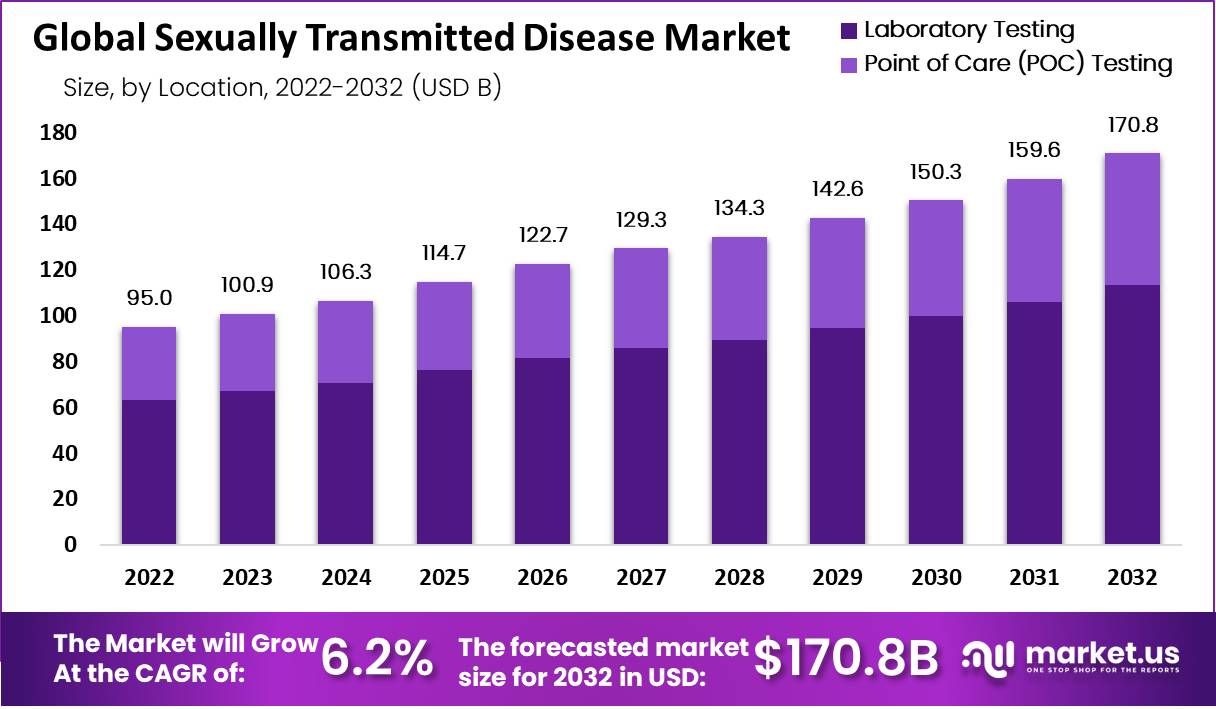
What is an STD?
Sexually transmitted diseases (STDs), also known as sexually transmitted infections (STIs), are infections transmitted through sexual activity, including vaginal, anal, and oral sex. Bacteria, viruses, or parasites can cause them and can affect both men and women of all ages.

Sexually Transmitted Diseases Statistics (STDs) – Key Facts
- More than 1 million STIs are acquired every day worldwide.
- In 2022, the World Health Organization (WHO) estimated 374 million new infections with 1 of 4 sexually transmitted infections (STIs):
- Chlamydia: 129 million new infections.
- Gonorrhea: 82 million new infections.
- Syphilis: 7.1 million new infections.
- Trichomoniasis: 156 million new infections.
More Insights
- In 2022, it was estimated that more than 490 million people were living with genital herpes.
- AS estimated 300 million women gave HPV infection, which is the primary cause of cervical cancer and anal cancer among men who have sex with men.
- Globally, an estimated 296 million people are living with chronic hepatitis B.
- Overall incidence rates have seen an upward trend; there have been nearly 30% more reportable sexually transmitted infections (STIs) reported between 2015 and 2019 in the US.
- In the United States, an estimated 12-12% of individuals between 14-49 years are estimated to be infected with herpes virus infection.
- Herpes Simplex Virus Type 2 affects an estimated worldwide prevalence of 500 Million People.
- HPV infections have been linked to over 310,000 cervical cancer deaths annually.
- Syphilis is the second leading cause of stillbirths worldwide.
- HIV/AIDS affected approximately 37 million people globally in 2022.
- Estimates show that 15% of HIV-infected individuals in the US remain unaware they are infected, accounting for 40% of new infections.
- According to the Centers for Disease Control (CDC), around 35,000 new HIV cases occur annually in the US.
- Mycoplasma genitalium is responsible for approximately 15% – 20% of all cases of non-gonococcal urethritis (NGU).
- Within the category of non-gonococcal urethritis (NGU), Mycoplasma genitalium accounts for approximately 20% – 25% of cases that are not caused by chlamydia.
- Mycoplasma genitalium is particularly associated with recurrent or persistent urethritis infections. It is estimated to be responsible for about 40% of all cases of recurrent or persistent urethritis.
(Source: WHO, NIH)
Common Sexually Transmitted Infections (STIs)
Human Immunodeficiency Virus (HIV)
Human Immunodeficiency Virus (HIV) is a retrovirus that attacks the immune system, specifically targeting CD4 cells, which are crucial for the body’s defense against infections. HIV gradually weakens the immune system, making the infected individual more susceptible to various infections and diseases.
- Since the beginning of the epidemic, approximately 84.2 million (64.0-113.0) million people have been infected with HIV.
- The number of deaths due to HIV stands at around 40.1 million (33.6-48.1 million people).
- Globally, at the end of 2021, approximately 38.4 million [33.9–43.8 million] people were living with HIV.
- The prevalence of HIV among adults aged 15-49 years worldwide is estimated to be around 0.7%.
- The WHO African region is the most severely affected, with nearly 1 in every 25 adults (3.4%) living with HIV.
- In 2021, a total of 36,136 people received an HIV diagnosis in the United States and its dependent areas.
- This number represents a 7% decrease in the annual number of new HIV diagnoses from 2017 to 2021.
- An estimated 1.2 million people in the United States had HIV at the end of 2021.
- Male-to-male sexual contact accounted for 67% of all new HIV diagnoses.
- The total number of new HIV diagnoses resulting from male-to-male sexual contact was 24,107 in 2021.
- Heterosexual contact accounted for 22% of all HIV diagnoses.
- The total number of new HIV diagnoses resulting from heterosexual contact was 8,059 in 2021.
(Source: WHO, CDC)
Global HIV Prevalence from 2010 to 2021
- The total number of people globally living with HIV has increased from 26 million people in 2000 to 38.4 million people in 2021.
(Source: Statista)
Take advantage of our unbeatable offer - buy now!


Chlamydia
Chlamydia is a common sexually transmitted infection (STI) caused by the bacterium Chlamydia trachomatis. It is one of the most frequently reported bacterial STIs worldwide.
- Chlamydia is the most common among young people, with two-thirds of new chlamydial infections occurring among youth aged 15-24 years.
- Approximately 1 in 20 sexually active young women aged 14-24 years has chlamydia.
- In 2021, chlamydia rates for African Americans/Blacks were six times higher than those of Whites.
- In 2020, there were about 1.5 million new cases of chlamydia in the United States.
- The number of reported chlamydia cases in 2020 decreased by 13% as compared to 2019.
(Source: CDC, very well health)
Chlamydia Rates by Ethnicity
| Ethnicity | Cases per 100,000 People (Rounded) |
| Black | 1,233 |
| American Indian or Alaska Native | 760 |
| Native Hawaiian or Other Pacific Islander | 733 |
| Hispanic or Latino | 387 |
| Multiple races | 231 |
| Non-Hispanic White | 210 |
| Asian | 128 |
Syphilis
Syphilis is a sexually transmitted infection caused by the bacterium Treponema pallidum. It can also be transmitted from a pregnant woman to her fetus during pregnancy or childbirth., which is known as congenital syphilis.
- In 2019, the ASIR of syphilis per 100,000 persons increased to 178.48 (95% UI: 134.94–232.34).
- 7.1 million adults were newly infected with syphilis in 2020.
- Each year, there are an estimated 6 million new cases of syphilis worldwide among individuals aged 15 to 49 years.
- Syphilis is the second leading cause of preventable stillbirth globally.
- Over 300,000 fetal and neonatal deaths are attributed to syphilis annually. These deaths occur due to complications arising from syphilis infection during pregnancy.
- In addition to the fetal and neonatal deaths, approximately 215,000 infants are placed at an increased risk of early death due to syphilis.
(Source: NIH)
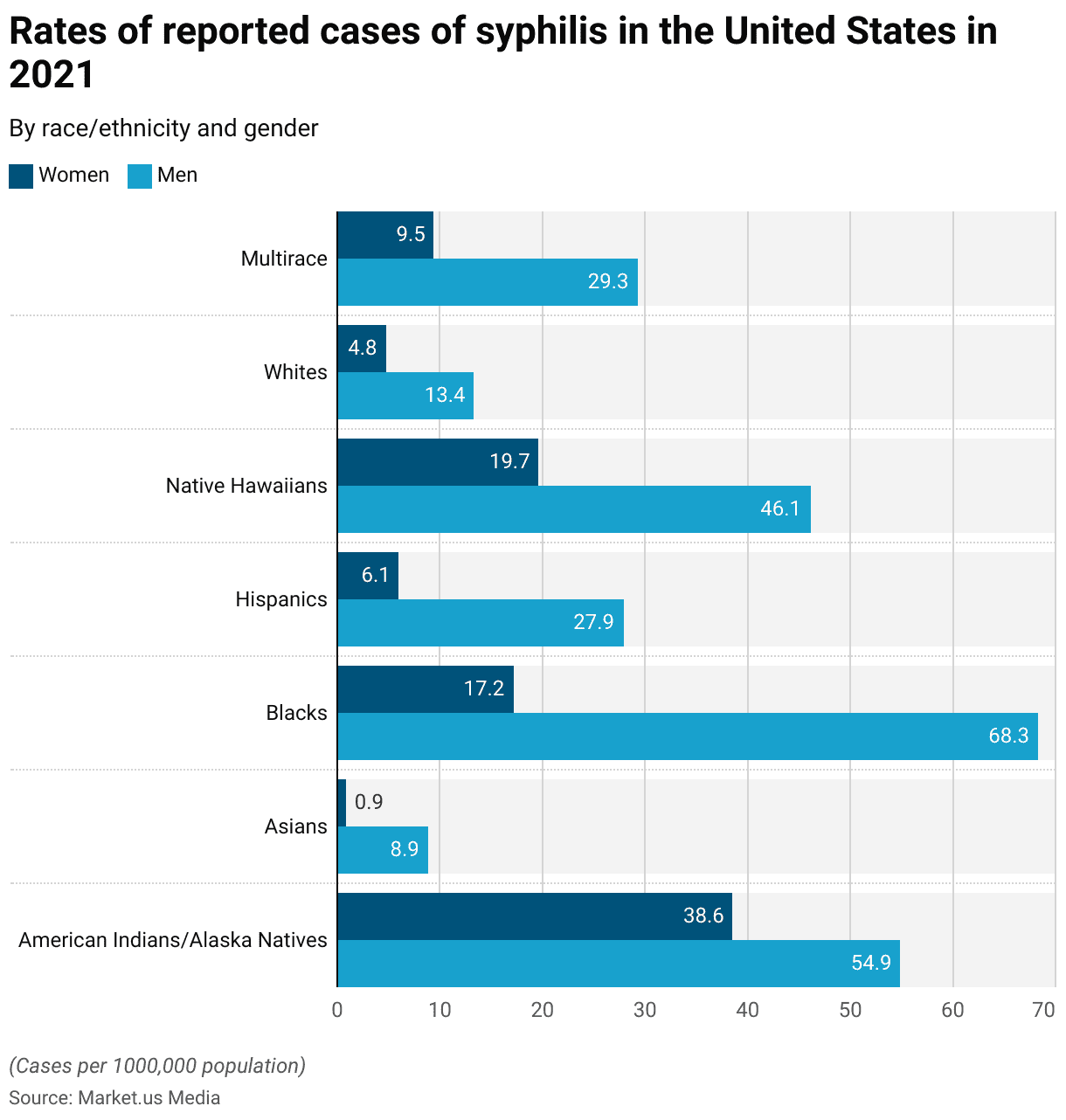
Herpes
Herpes is a sexually transmitted infection (STI) caused by the herpes simplex virus (HSV). There are two main types of herpes viruses: herpes simplex virus type 1 (HSV-1) and herpes simplex virus type 2 (HSV-2).
- Approximately 3.7 billion people under the age of 50, which accounts for 67% of the global population in that age group, are estimated to have HSV-1 infection.
- Around 491 million people aged 15 to 49, which corresponds to 13% of that age group worldwide, are estimated to have HSV-2 infection.
- In 2016, approximately 491.5 million individuals, which accounted for around 13.2% of the global population aged 15 to 49 years, were living with HSV-2 infection.
- It is estimated that between 122 million to 192 million people have genital HSV-1 infections.
(Source: WHO)
Human Papillomavirus (HPV)
Human Papillomavirus (HPV) is a common sexually transmitted infection (STI) caused by the human papillomavirus. HPV is a group of over 200 related viruses, and some of them can cause various health problems.
- In 2018, it is estimated that there were 43 million HPV infections in the United States.
- During the same year, there were approximately 13 million new HPV infections.
- Genital warts caused by HPV affected around 340,000 to 360,000 people annually before the introduction of HPV vaccines.
- Each year, nearly 12,000 women in the U.S. are diagnosed with cervical cancer.
- Despite screening and treatment, over 4,000 women die from cervical cancer annually.
- Each year, about 19,400 women and 12,100 men in the U.S. experience cancers caused by HPV.
(Source: CDC)
Hepatitis B
Hepatitis B is a sexually transmitted infection (STI) caused by the hepatitis B virus (HBV). It primarily affects the liver and can lead to acute or chronic hepatitis. HBV is transmitted through contact with the blood, semen, or other body fluids of an infected person.
- Approximately 296 million people are affected by Hepatitis B worldwide.
- Out of the total affected population, over 6 million are children under the age of 5.
- Hepatitis B contributes to an estimated 820,000 deaths annually.
- About 25% of chronic Hepatitis B infections progress to liver cancer.
- In 2021, over half of all newborns worldwide were not protected by a universal hepatitis B vaccine within 24 hours of birth.
- The hepatitis B vaccine is estimated to prevent 38 million deaths over the lifetime of individuals born between 2000 and 2030 in 98 low- and middle-income countries.
- Between 2001 and 2020, hepatitis B vaccines saved an estimated $49 billion in the cost of illness in 73 low- and middle-income countries.
- Between 2001 and 2020, hepatitis B vaccines saved an estimated $81 billion in total economic and societal value in 73 low- and middle-income countries.
(Source: CDC)
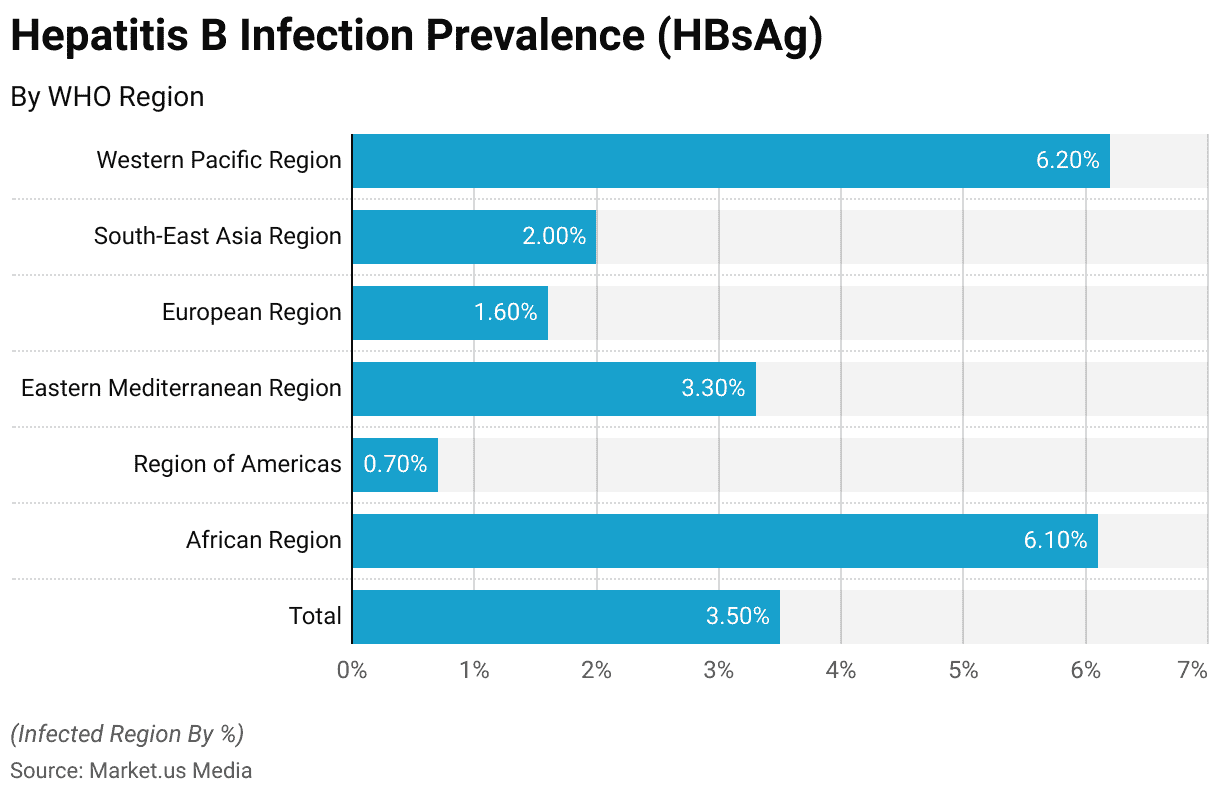
Trichomoniasis
Trichomoniasis, also known as “trich,” is a common sexually transmitted infection (STI) caused by a parasitic protozoan called Trichomonas vaginalis. It primarily affects the urogenital tract, including the vagina in women and the urethra in both men and women.
- In 2018, an estimated 2.6 million cases of trichomoniasis were reported in the United States.
- The prevalence of trichomoniasis among women aged 14-59 years was 2.1% in 2022 and 0.5% among men.
- The prevalence of trichomoniasis among African American Women was about 9.6%, Hispanic Women 1.4%, and Non-Hispanic White Women about 0.8%.
(Source: CDC)
The worldwide incidence and prevalence of trichomoniasis are reflected in the following table.
| Region | Gender | Incidence/100,000/yr | Prevalence/100,000 |
| Africa | M | 16,500 | 2000 |
| F | 14,600 | 20,200 | |
| The Americas | M | 1,806 | 2,200 |
| F | 17,700 | 22,000 | |
| South East Asia | M | 5,000 | 600 |
| F | 4,030 | 5,600 | |
| Europe | M | 4,840 | 600 |
| F | 5,170 | 5,800 | |
| East Mediterranean | M | 6,600 | 800 |
| F | 6,400 | 8000 | |
| The western Pacific region includes China and Australia | M | 4,700 | 600 |
| F | 4,600 | 5,700 | |
| United States of America | F | 358 | 310 |
Sexually Transmitted Diseases Statistics – Prevention and Control
Sexually Transmitted Diseases Statistics – Condom Usage
- According to the World Health Organization (WHO), an estimated 27% of men globally (aged 15-49) reported using a condom during their last sexual intercourse in 2019.
- In 2019, approximately 1.9 billion women of reproductive age (15-49 years) worldwide.
- Among these women, around 1.1 billion needed family planning.
- Out of the 1.1 billion women with a need for family planning:
- 842 million were current users of modern methods of contraception.
- 80 million were using traditional methods of contraception.
- 190 million women had an unmet need for family planning, meaning they wanted to avoid pregnancy but were not using any contraceptive method.
- According to the United Nations Population Fund (UNFPA), in 2019, an estimated 46% of men globally used condoms during their last sexual intercourse.
- The Joint United Nations Programme on HIV/AIDS (UNAIDS) reported that in 2019, among women aged 15-24 years in sub-Saharan Africa, approximately 32% reported using condoms during their last sexual intercourse.
- In some countries, the reported use of male condoms as a modern contraceptive method ranged from less than 10% to over 30%.
- It is estimated that some 33.44 million Americans used condoms in 2020.
(Source: United Nations, CDC, Statista)
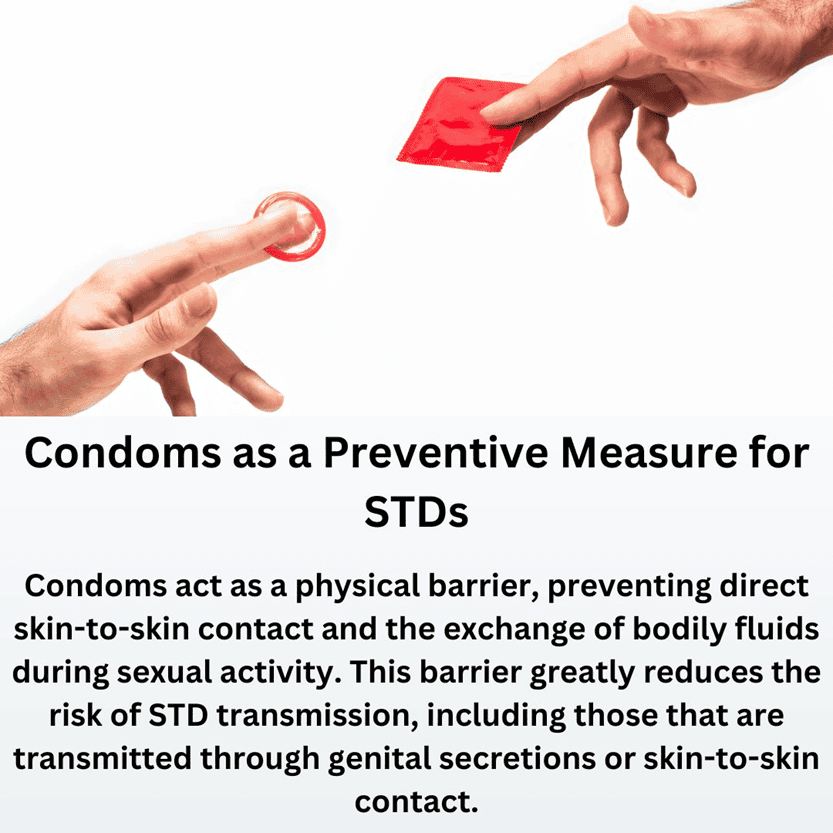
Sexually Transmitted Diseases Statistics – Vaccination
- As of September 2021, 106 countries have introduced HPV vaccination in their national immunization programs.
- In some high-income countries, coverage rates among adolescent girls have reached or exceeded 80%.
- According to the WHO, as of September 2021, 84% of countries worldwide had included hepatitis B vaccination in their national immunization programs.
- Global coverage with three doses of the hepatitis B vaccine among infants increased from 31% in 2000 to 84% in 2020.
- According to the Centers for Disease Control and Prevention (CDC), as of 2021, approximately 51.1% of adolescents aged 13-17 years in the United States had completed the HPV vaccination series.
(Source: WHO)
Sexually Transmitted Diseases Statistics – Health Promotion and Education
- According to a study published in the journal PLOS ONE in 2020, there were significant gaps in knowledge about STDs among young adults in the United States. Only 57.5% of participants correctly identified all major symptoms of common STDs.
- Among college students in the United States, 44% had inadequate knowledge of human papillomavirus (HPV) transmission and prevention.
- The Centers for Disease Control and Prevention (CDC) estimates that consistent and correct condom use reduces the risk of HIV transmission by approximately 80% and the risk of gonorrhea and chlamydia transmission by 50-70%.
- According to a report by the Guttmacher Institute in 2020, as of 2020, 27 U.S. states and the District of Columbia required sex education to be taught in schools, but only 8 of those states required the information to be medically accurate.
Sexually Transmitted Diseases Statistics by Country
United States
The United States has consistently reported high rates of STDs, including chlamydia, gonorrhea, and syphilis. According to the Centers for Disease Control and Prevention (CDC), there has been a steady increase in STD cases in recent years.
- Chlamydia is the most commonly reported STD in the United States.
- In 2021, there were approximately 1.8 million reported cases of chlamydia.
- In 2021, there were over 600,000 reported cases of gonorrhea.
- In 2021, there were over 129,000 reported cases of syphilis (all stages).
- In 2021, there were approximately 34,800 new HIV diagnoses in the United States.
- It is estimated that nearly 80 million Americans are currently infected with HPV.
- In 2018, there were 13 million new cases of human papillomavirus (HPV).
(Source: CDC, Statista)
Sexually Transmitted Diseases Statistics Incidence in the US

South Africa
South Africa has one of the highest HIV/AIDS prevalence rates globally. The country has also reported high rates of other STDs such as syphilis and gonorrhea.
- In 2020, an estimated 7.8 million people were living with HIV/AIDS in South Africa, which is the highest number of people affected by HIV/AIDS in any single country.
- The prevalence of HIV among adults (aged 15-49) was estimated to be around 20.4% in 2020.
- An estimated 7.9 million people were living with HIV in South Africa.
- The prevalence of HIV among adults (aged 15-49) was approximately 20% in 2022.
- The estimated number of new cases of gonorrhea in South Africa was about 2.3 million in 2022.
- The estimated number of new cases of chlamydia and syphilis was 1.9 million and 23,175 respectively in South Africa.
- In 2022, the estimated number of deaths from AIDS in South Africa reached 85,796.
(Source: Nicd, Statista)
India
India has a high burden of STDs, particularly HIV/AIDS. The country also reports a significant number of cases of chlamydia, gonorrhea, and syphilis.
- Around 6% of the adult population in India is estimated to have one or more STIs/RTIs.
- This translates to approximately 30-35 million episodes of STIs/RTIs occurring every year.
(Source: NIH)
Prevalence of Sexually Transmitted Diseases Among Men in India
| Syphilis | 12.6-57% |
| Chlamydia | 20-3-% |
| Chancroid | 9.9-34.7% |
| Gonorrhea | 8.5-25.9% |
| HSV | 3.0-141.9% |
| HPV | 4.9-14.30% |
Brazil
Brazil has a high prevalence of STDs, including HIV/AIDS, syphilis, and human papillomavirus (HPV) infections. The country has implemented various programs to address these health issues.
According to a study conducted in six Brazilian states, the prevalence rates of sexually transmitted infections (STIs) among women living with HIV were as follows:
- The study found a prevalence rate of 2.1% of Chlamydia among women living with HIV.
- The prevalence rate of gonorrhea among women living with HIV was reported as 0.9%.
- The study also identified a prevalence rate of 2.7% for coinfection of Chlamydia and gonorrhea among women living with HIV.
Sexually Transmitted Diseases Statistics – HIV in Brazil 2015-2021
- In 2021, approximately 960,000 people were living with HIV in Brazil, up from around 920,000 cases recorded a year earlier.
(Source: Statista)
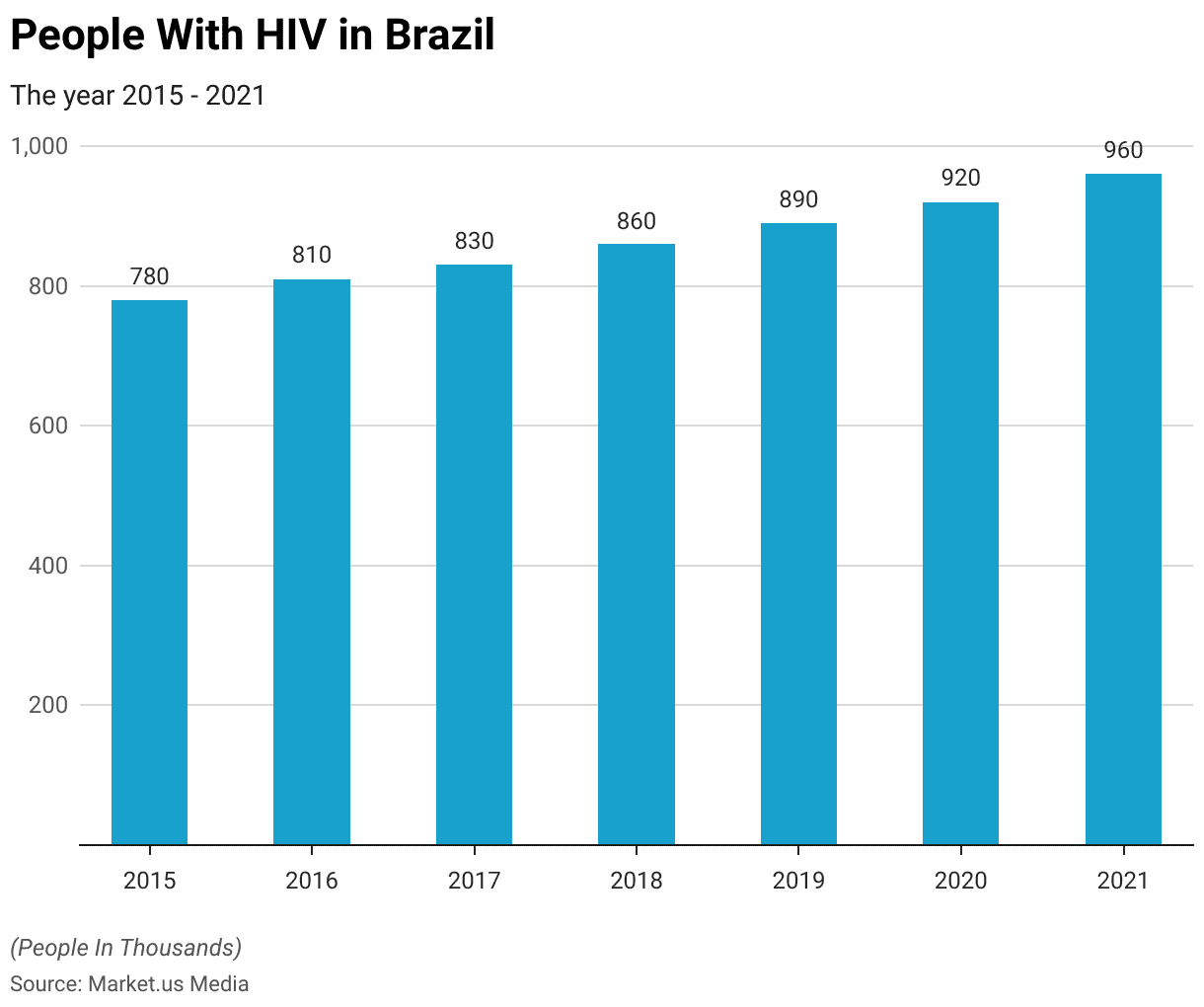
Russia
Russia has reported significant rates of STDs, particularly HIV/AIDS and syphilis. The country has faced challenges in controlling the spread of these infections, particularly among vulnerable populations.
- As of 2020, an estimated 1.4 million people were living with HIV in Russia. The prevalence rate among adults aged 15-49 was approximately 1.1%.
- In 2019, there were over 97,000 reported cases of syphilis, with a rate of around 66 cases per 100,000 population.
- In 2019, there were more than 77,000 reported cases of gonorrhea, with a rate of approximately 53 cases per 100,000 population.
- In 2019, there were over 475,000 reported cases of chlamydia, with a rate of around 326 cases per 100,000 population.
(Source: NIH)
Recent Developments
Acquisitions and Mergers:
- STD Testing Solutions acquired PreventionCare for $600 million, consolidating its position in the STD testing and prevention market and expanding its network of clinics and online services.
- HealthTech merged with STD Care Services, forming a strategic partnership to enhance STD treatment and management services, with combined resources aimed at addressing the rising rates of STDs.
New Product Launches:
- STDTech introduced a rapid home testing kit for common STDs, offering discreet and convenient testing options, aiming to reach 1 million users within the first year.
- PreventionPlus launched a mobile app for STD prevention education and risk assessment, providing information on safe sex practices and nearby testing facilities, targeting 500,000 downloads within six months.
Funding Rounds:
- STDHealth received $50 million in Series A funding led by Healthcare Investment Group XYZ to expand their STD treatment clinics and invest in outreach programs for high-risk populations, aiming for a 50% increase in patient visits within the next year.
- PreventionNow secured $30 million in seed funding from Tech Investors ABC to develop innovative STD prevention technologies and establish partnerships with community organizations, targeting a 40% reduction in STD transmission rates over the next fiscal year.
Public Health Initiatives:
- Public health agencies launched campaigns to raise awareness about STD prevention, testing, and treatment, targeting high-risk demographics such as adolescents and young adults.
- Government-funded STD clinics expanded their services to provide comprehensive care, including testing, treatment, counseling, and partner notification services.
Research and Development:
- Research institutions and pharmaceutical companies invested in developing new treatments and vaccines for STDs, focusing on drug-resistant strains and emerging infections such as antibiotic-resistant gonorrhea.
- Studies on STD epidemiology and transmission dynamics informed public health interventions and policy decisions to control the spread of STDs.
Telemedicine and Telehealth Services:
- Telemedicine platforms expanded their offerings to include virtual consultations and prescriptions for STD testing and treatment, improving access to care for underserved populations and those reluctant to visit healthcare facilities.
Global Burden of STDs:
- The global burden of STDs continued to rise, with an estimated 1 million new cases of curable STDs occurring each day worldwide.
- STD rates among certain populations, including adolescents, MSM, and racial and ethnic minorities, remained disproportionately high.
Wrap Up
Sexually transmitted diseases remain a significant public health challenge globally. The prevalence of STDs underscores the importance of preventive measures, such as regular screening, safe sexual practices, and vaccination where available.
Early detection and appropriate treatment are crucial in controlling the spread and mitigating long-term health consequences.
Additionally, comprehensive sexual education plays a vital role in raising awareness and empowering individuals to make informed decisions regarding their sexual health.
In an ever-evolving landscape, continued research and collaboration are essential for the development of novel treatments and strategies to combat the spread of STDs.
FAQ’s
Common STDs include Chlamydia, Gonorrhea, Human Papillomavirus (HPV), Herpes (HSV), Syphilis, Trichomoniasis, and HIV/AIDS.
They are usually transmitted through sexual contact, including vaginal, anal, and oral sex. Some STDs, like HIV, can also be transmitted through sharing needles or from mother to child during childbirth.
Symptoms vary widely. Some STDs have no symptoms, especially in the early stages. Common symptoms can include sores or bumps on the genitals or oral area, unusual discharge from the penis or vagina, itching, pain during intercourse, and flu-like symptoms.
Using condoms or dental dams during sexual activity can reduce the risk of contracting an STD. Regular testing, vaccination for HPV and Hepatitis B, and limiting the number of sexual partners are also helpful preventive measures.
While condoms greatly reduce the risk of transmission, they are not 100% effective. Some STDs, like herpes and HPV, can be spread through skin-to-skin contact, which may not be completely covered by a condom.
Discuss your needs with our analyst
Please share your requirements with more details so our analyst can check if they can solve your problem(s)



